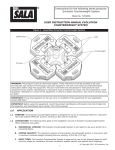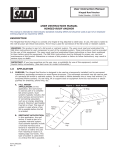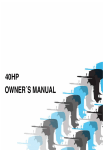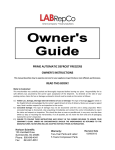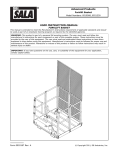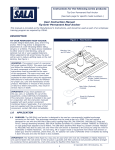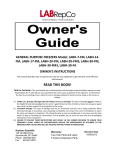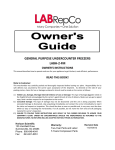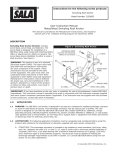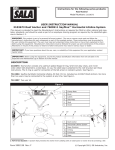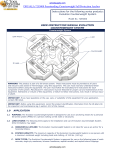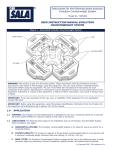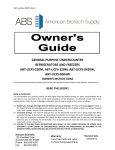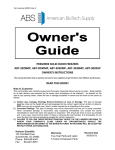Download - TTT Environmental
Transcript
Instructions for the following series products: Perimeter Limiter System Model No. 2100090, 2100091 User Instruction Manual Perimeter Limiter Counterweight System Figure 1 - Assembled Perimeter Limiter Counterweight System Mast: 7.5 ft or 9.5 ft. (2.3 m or 2.9 m) Mast Arm Lifting Shackles Positioning Handles Rear Foot Pad Jack Weight Cart Anchor Points Positioning Bars Additional Weights (Optional) Front Foot Pad Jack WARNING: This product is part of a fall arrest system. These instructions must be provided to all users and rescuers (see section 8 Terminology) using this equipment. The user must read and understand these instructions before using this equipment. The user must follow the manufacturer’s instructions for each component of the system. Manufacturer’s instructions must be followed for proper use and maintenance of this equipment. Alterations or misuse of this equipment, or failure to follow instructions, may result in serious injury or death. IMPORTANT: If you have questions on the use, care, or suitability of this equipment for your application, contact DBI‑SALA. IMPORTANT: Before using this equipment, record the product identification information from the ID label into the inspection and maintenance log in section 10.0 of this manual. 1.0APPLICATION 1.1 PURPOSE: The Perimeter Limiter System is designed for use as an anchoring means for a personal fall arrest system (PFAS) for a person working on form work, flat roofs or similar structures. 1.2 LIMITATIONS: The following limits apply to the installation and use of Perimeter Limiter System. Other limitations may apply: A. HORIZONTAL LIFELINE: The Perimeter Limiter System is not rated for use as an anchor for a horizontal lifeline. B. SYSTEM CAPACITY: The maximum capacity of the Perimeter Limiter System is two persons, each with a maximum combined weight including tools and clothing, of 310 lbs. (141 kg). C. surface Conditions: The Perimeter Limiter System must not be used under conditions where the surface is coated with frost, snow, ice, standing water, grease or oil, or other lubricating or friction reducing materials. © Copyright 2007, DB Industries, Inc. D. PERSONAL FALL ARREST SYSTEM: PFASs used with this roof anchor must meet applicable OSHA, state, federal and ANSI requirements. PFASs incorporating a full body harness must be capable of arresting a worker’s fall with a maximum arresting force of no greater than 900 lbs. (4 kN) and limit the free fall distance to 6 ft. (1.8 m) or less. The deceleration distance for a PFAS must be 42 inches (1.1 m) or less [47 inches (1.2 m) in Canada]. Reference ANSI Z359.1, OSHA and CSA Z259.11 requirements. The system must be rigged in a way that limits free fall to 6 ft. or less. Contact DBI‑SALA if you have questions or concerns regarding free fall limits. e. Surface Structure: The surface on which the Perimeter Limiter is installed must be capable of supporting the weight of the Perimeter Limiter and any additional loading as a result of fall arrest forces. Do not install the system on an uneven surface or a slope of greater than 5°. f. ENVIRONMENTAL HAZARDS: Use of this equipment in areas where environmental hazards exist may require additional precautions be taken to reduce the possibility of injury to the user or damage to the equipment. Hazards may include, but are not limited to: high heat, extreme cold, caustic chemicals, corrosive environments, high voltage power lines, explosive or toxic gases, moving machinery, or sharp edges. Contact DBI‑SALA if you have questions about using this equipment where environmental hazards exist. Figure 2 -System Location g. Location: The Perimeter Limiter must be located a sufficient distance from the edge of a working surface. Minimum distance allowable from the front of the unit is 2 ft. (.6 m) and from the side of the unit is 3 ft. (.9 m) See Figure 2. 2 ft Min. H. TRAINING: This equipment must be installed and used by persons who have been properly trained in its correct application and use. Installation and use of this equipment must be supervised by a qualified person, as defined by OSHA fall protection standards. (.6 m Min.) Front Leading Edge 3 ft Min. (.9 m Min) Side Leading Edge 1.3 Applicable standards: Refer to national Standards including ANSI Z359 (.0, .1, .2, .3, and .4) family of standards on fall protection, ANSI A10.32, and applicable local, state and federal (OSHA) requirements governing occupational safety for more information about work positioning systems. Refer to CSA Z259.13 in Canada for more information on personal fall arrest systems and associated components. 2.0SYSTEM REQUIREMENTS 2.1 COMPATIBILITY OF COMPONENTS: DBI‑SALA equipment is designed for use with DBI‑SALA approved components and subsystems only. Substitutions or replacements made with non-approved components or subsystems may jeopardize compatibility of equipment and may effect the safety and reliability of the complete system. 2.2 COMPATIBILITY OF CONNECTORS: Connectors are considered to be compatible with connecting elements when they have been designed to work together in such a way that their sizes and shapes do not cause their gate mechanisms to inadvertently open regardless of how they become oriented. Contact DBI‑SALA if you have any questions about compatibility. Connectors (hooks, carabiners, and D‑rings) must be capable of supporting at least 5,000 lbs. (22.2 kN). Connectors must be compatible with the anchorage or other system components. Do not use equipment that is not compatible. Non-compatible connectors may unintentionally disengage. See Figure 3. Connectors must be compatible in size, shape, and strength. Self locking snap hooks and carabiners are required by ANSI Z359.1 and OSHA and CSA Z259.12 in Canada. 2.3 MAKING CONNECTIONS: Only use self-locking snap hooks and carabiners with this equipment. Only use connectors that are suitable to each application. Ensure all connections are compatible in size, shape and strength. Do not use equipment that is not compatible. Ensure all connectors are fully closed and locked. Figure 3 - Unintentional Disengagement (Roll-out) If the connecting element that a snap hook (shown) or carabiner attaches to is undersized or irregular in shape, a situation could occur where the connecting element applies a force to the gate of the snap hook or carabiner. This force may cause the gate (of either a self-locking or a non-locking snap hook) to open, allowing the snap hook or carabiner to disengage from the connecting point. Small ring or other non-compatibly shaped element 1. Force is applied to the snap hook. 2. The gate presses against the connecting ring. 3. The gate opens allowing the snap hook to slip off. DBI‑SALA connectors (snap hooks and carabiners) are designed to be used only as specified in each product’s user’s instructions. See Figure 4 for inappropriate connections. DBI‑SALA snap hooks and carabiners should not be connected: A. To a D‑ring to which another connector is attached. B. In a manner that would result in a load on the gate. Figure 4 - Inappropriate Connections NOTE: Large throat snap hooks should not be connected to standard size D‑rings or similar objects which will result in a load on the gate if the hook or D‑ring twists or rotates. Large throat snap hooks are designed for use on fixed structural elements such as rebar or cross members that are not shaped in a way that can capture the gate of the hook. C. In a false engagement, where features that protrude from the snap hook or carabiner catch on the anchor and without visual confirmation seems to be fully engaged to the anchor point. D. To each other. E. Directly to webbing or rope lanyard or tie-back (unless the manufacturer’s instructions for both the lanyard and connector specifically allows such a connection). F. To any object which is shaped or dimensioned such that the snap hook or carabiner will not close and lock, or that roll-out could occur. 2.4 Installation LOAD: The surface on which the Perimeter Limiter is installed must be capable of supporting the weight of the unit and fall arrest loads. The maximum static load is 470 lbs. (213 kg), the maximum foot pad loading during fall arrest for one user is 1,200 lbs. (545 kg) and 2000 lbs. (900 kg) for two users. See section 7, for the weight of each Perimeter Limiter model. 3.0Assembly AND USE WARNING: Do not alter or intentionally misuse this equipment. Consult with DBI‑SALA if using this equipment in combination with components or subsystems other than those described in this manual. Some subsystems and components combinations may interfere with the proper operation of this equipment. Use caution when using this equipment around moving machinery, electrical and chemical hazards, and sharp edges. WARNING: Working at height has inherent risks. Some risks are noted here but are not limited to the following: falling, suspension/prolonged suspension, striking objects, and unconsciousness. In the event of a fall arrest and/ or subsequent rescue (emergency) situation, some personal medical conditions may affect your safety. Medical conditions identified as risky for this type of activity include but are not limited to the following: heart disease, high blood pressure, vertigo, epilepsy, drug or alcohol dependence, psychiatric illness, impaired limb function and balance issues. We recommend that your employer/physician determine if you are fit to handle normal and emergency use of this equipment. 3.1 BEFORE EACH USE inspect this equipment according to steps listed in section 5. Do not use this equipment if inspection reveals an unsafe or defective condition. Plan your use of the fall protection system prior to exposing workers to dangerous situations. Consider all factors affecting your safety before using this system. Read and understand all manufacturer’s instructions for each component of the personal fall arrest system. All DBI-SALA harnesses and connecting subsystems are supplied with separate user instructions. Keep all instructions for future reference. 3.2 PLANyour fall arrest system before starting your work. Take into consideration factors affecting your safety at any time during use. The following list gives some important points you must consider when planning your system: A. Surface Structure: The surface structure must be capable of supporting the required loads. See section 2.4. Figure 5 - Safe Work Zone B. OTHER CONSIDERATIONS: • Always work within the safe work zone of the Perimeter Limiter to avoid the possibility of rocking or tipping the unit. See Figure 5. • Personal fall arrest systems must be rigged to limit any free fall to a maximum of 6 ft. (1.8 m) (OSHA and ANSI Z359.1) (see section 1.2 F). • Do not work above the surface of the Perimeter Limiter level since an increased free fall distance will result. • Avoid working where your line may cross or tangle with that of another worker or another object. • Do not allow the lifeline to pass under arms or between legs. 2 ft. Min (.3 m Min) Front Leading Edge 26 ft. Max (7.9 m Max) Side Leading Edge 24 ft. Max (7.9 m Max) Perimeter Limiter Safe Work Zone • Never clamp, knot or otherwise prevent the lifeline from retracting or being taut, avoid slack line. • The Perimeter Limiter has two shackles designed for lifting the unit: one on the gusset at the base of the mast and the other on the top center of the weight cart. See Figure 1. Use these shackles for lifting the unit to the work area. Always use both shackles when lifting the unit. Warning: Do not attach a personal fall arrest system to the lifting shackles. The shackles are not rated for fall arrest and in the event of a fall, serious injury or death could occur. Important: Do not lengthen the SRL lifeline by connecting a lanyard or similar component without consulting DBI‑SALA. C. TOTAL FALL DISTANCE: Should a fall occur, there must be sufficient clearance in the fall area to arrest the fall before striking the ground or other object. The total fall distance is the distance measured from the onset of a fall to the point where the fall is arrested. A number of factors can influence the total fall distance including; user’s weight, anchorage location relative to the fall (swing fall), body support with sliding D‑ring, and the type of fall arrest equipment you attach to the anchor. For specific clearance requirements read and follow the manufacturers’s instructions for your fall arrest equipment. D. SWING FALLS: See Figure 6. Swing falls occur when the anchorage point is not directly above the point where a fall occurs. The force of striking an object while swinging (horizontal speed of the user due to the pendulum affect) can be great and may cause serious injury. Swing falls can be minimized by working as close to the anchorage point as possible. In a swing fall situation, the total vertical fall distance of the user will be greater than if the user had fallen vertically directly below the anchorage point. The user must therefore account for an increase in the total free fall distance and the area needed to safely arrest the fall. E. SHARP EDGES: Avoid working where the connecting subsystem (i.e. self retracting lifeline (SRL), full body harness, lanyard, lifeline, etc.) or other system components will be in contact with, or abrade against unprotected sharp edges. See Figure 7. If working with this equipment near sharp edges is unavoidable, protection against cutting must be provided by using a heavy pad or other means over the exposed sharp edge. If you are not using the Leading Edge SRL (PN 3504500 or 3504600), it is recommended that an energy absorber (PN 1220362) be installed in-line between the harness and the self retracting lifeline to further protect the worker. Compatibility and total fall distance issues must be considered if this is done. Contact DBI‑SALA before using in-line energy absorbing components or lanyards with self retracting lifelines. F. RESCUE: When using this equipment, the employer must have a rescue plan and the means at hand to implement it and must communicate that plan to users, authorized persons, and rescuers. G. AFTER A FALL: Any equipment which has been subjected to the forces of arresting a fall or exhibits damage consistent with the effect of fall arrest forces as described in section 5, must be removed from service immediately and destroyed by the user, the rescuer, or an authorized person. WARNING: Read and follow the manufacturer’s instructions for associated equipment (i.e. SRL, full body harness, lanyard, lifeline, etc.) used in your personal fall arrest system. Figure 6 - Swing Falls Unexpected Hazards Swing Fall Hazard Figure 7 - Sharp Edges Leading Edge SRL Carabiner Full Body Harness Padding 3.3 SYSTEM assembly: Figure 1 shows the Perimeter Limiter Sharp Edge Anchor assembled. The Perimeter Limiter is shipped with the mast arm installed backwards Figure 8 Unit Alignment for space saving concerns. When the anchor arrives, remove the bolt that goes through the mast and arm, remove the arm and rotate it 180° to its proper orientation and replace it. Then replace the bolt through the arm and mast and tighten the nut with a wrench. Warning: The Perimeter Limiter Anchor system must only be used with the arm extending in the direction opposite the weight cart within 45° (see Figure 8). Any other orientation will diminish the effectiveness to the counterweight system and use could result in severe injury or death. 45° 45° 3.4 Operation Step 1. Position the Unit: Use the positioning handles on the rear of the weight cart and positioning bars on the front of the unit (see Figure 1) to position the unit at the desired work location, within the requirements of section 3.2. Step 2. Once the unit is in proper position and alignment, Raise the front and rear tire jacks until the foot pads reach the work surface. Continue to rotate the jack handles until all three wheels are lifted off the work surface and rotate freely to ensure the weight of the unit is transferred to the foot pads. Step 3. Attach your personal fall arrest system (PFAS) to the attachments points on the mast arm (see Figure 1). Refer to the PFAS manufacturer’s instructions for correct attachment and use of the PFAS. Do not attach more than one PFAS to an attachment point. Do not attach more that two PFAS to the Perimeter Limiter. Warning: Do not move the Perimeter Limiter while a user is attached to it. 3.5 Optional Mast for 9.5 ft. (2.9 m) configuration: If you are retrofitting your Perimeter Limiter with the optional 9.5 ft. (2.9 m) mast, remove the mast arm as previously indicated. After the mast arm is removed, remove the bolt at the base of the mast and lift the mast off the base. Replace the old mast with the new one and replace the original bolt and nut, then place the mast arm on top of the new mast and replace its bolt and nut. Be sure to tighten both nuts with a wrench to make sure they are snug. Along with the 9.5 ft (2.9 m) mast, you need to install an additional weight set into the weight box. To install the extra weights, Use the lifting point shackles to raise the Perimeter Limiter about 1 ft. (.3 m) off the ground. Place two of the weights inside the weight box and center them over one of the mounting holes in the permanent weights. Slide one of the supplied long, 1-in. bolts into the hole from the bottom of the cart and apply the washer and nut to the end of the bolt after it has passed through the two extra weights. Snug the nut down with a wrench. Repeat this procedure with the other two extra weights over the second mounting hole. Warning: Do not use the 9.5 ft. mast without installing the additional weights. In the event of a fall without the additional weights, the anchor could tip causing sever injury or death. 3.6 BODY SUPPORT: A full body harness must be worn for fall arrest applications. For general fall protection use, connect to the D‑ring on the back between the shoulders (dorsal D‑ring). IMPORTANT: Body belts are not allowed for free fall situations. Body belts increase the risk of injury during fall arrest in comparison to a full body harness. Limited suspension time and the potential for improperly wearing a body belt may result in added danger to the user’s health. 3.7 Optional Digital Winch: If you purchase a Digital Winch, a mounting bracket is shipped with it. To mount the Digital Winch, remove the detent pin from the winch mounting bracket, place the slot on the lower edge of the bracket onto the pin on the bracket on the Perimeter Limiter mast and then rotate the winch toward the mast until the upper holes in the two brackets align. Insert the detent pin through the holes in both brackets. Make sure the detent pin goes all the way through both brackets and clicks into place. See Figure 9. Route the winch’s wire rope over the roller at the top of the mast and over the pulley at the center of the mast arm. Refer to the Digital Winch user instruction for proper use and inspection. Figure 9 - Digital Winch Detent Pin 3.8 CONNECTING TO THE Perimeter Limiter ANCHOR: Figure 7 illustrates the proper connection of typical fall arrest equipment to the Perimeter Limiter anchor. Always protect the lifeline from abrading against sharp or abrasive surfaces on the roof. Make sure all the connections are compatible in size, shape and strength. Never connect more than two personal protective system to a Perimeter Limiter at a time. SRL: Connection to the installed Perimeter Limiter anchor may be made by using a carabiner to attach a self retracting lifeline (SRL) to one of the anchor points on the mast arm of the Perimeter Limiter and then attaching the self locking snap hook at the end of the SRL lifeline to the back dorsal D‑ring (fall arrest attachment point) of the user’s body support (i.e. full body harness). When connecting, make sure the connections are fully closed and locked. Review section 3.2 if using an SRL near sharp edges. ENERGY ABSORBING LANYARDS OR LIFELINE: Connect the energy absorbing end of the lanyard to the back D‑ring on the full body harness (see section 3.6). See manufacturer’s instruction for more information. 3.9 NORMAL OPERATION: Once attached, the worker is free to move about within the recommended working areas. If a fall has been arrested, the system must be taken out of service and inspected, see section 5.0. 4.0TRAINING 4.1 It is the responsibility of all users of this equipment to understand these instructions, and are trained in the correct installation, use, and maintenance of this equipment. These individuals must be aware of the consequences of improper installation or use of this equipment. This user manual is not a substitute for a comprehensive training program. Training must be provided on a periodic basis to ensure proficiency of the users. 5.0 INSPECTION 5.1 BEFORE EACH INSTALLATION: Inspect the Perimeter Limiter components, and other system components according to these or other manufacturer’s instructions. System components must be formally inspected by a qualified person (other than the user) at least annually. Formal inspections should concentrate on visible signs of deterioration or damage to the system components. Items found to be defective must be replaced. Do not use components if inspection reveals an unsafe or defective condition. Record results of each inspection in the inspection and maintenance log in section 10.0 of this manual. 5.2 INSPECTION STEPS: Step 1. If additional weights have been installed, make sure the bolts and nuts holding them in place are snug and secure. Step 2. Inspect the Perimeter Limiter Anchor for physical damage. Look carefully for any signs of cracks, dents or deformities in the metal. Do not use an anchor that has been subjected to fall arrest forces unless it has been inspected by a competent person and permission to use it has been expressed in writing. Step 3. Inspect the Perimeter Limiter Anchor for signs of excessive corrosion. 5.3 If inspection reveals an unsafe or defective condition, remove the unit from service and destroy, or contact DBI‑SALA for possible repair. 5.4 USER EQUIPMENT: Inspect each system component or subsystem (i.e. SRL, full body harness, lanyard, lifeline, etc.) per associated manufacturer’s instructions. Refer to manufacturer’s instruction supplied with each system component for inspection procedures. 6.0 MAINTENANCE, SERVICE, STORAGE 6.1 The Perimeter Limiter System components require no scheduled maintenance other than periodic greasing of the weight box pin bushing and the shaft for the swivel wheel at the front of the unit and repair or replacement of items found defective during inspection. See section 5.0. If components become heavily soiled with grease, paint, or other substances, clean with appropriate cleaning solutions. Do not use caustic chemicals that could damage system components. 7.0SPECIFICATIONS 7.1 MATERIALS: Mast: powder-coated steel Mast Arm: powder-coated steel Base Arm: powder-coated steel Weight Box: galvanized steel 7.2 Weight: Model No. 2100090 (7.5 ft. [2.3 m] configuration): 1655 lbs. (751 kg) Kit Model No. 2100091 (9.5 ft [2.9 m] configuration): 1855 lbs. (841 kg) (includes 200 lbs. [91 kg] of additional weight and mast for 9.5 ft. [2.9 m] configuration). Additional Counterweight: 50 lbs. (23 kg) each. 7.3 Dimensions: 74 in. (1.9 m) 48 in. (1.2 m) 4 in. (.1 m) 188.5 in. (4.8 m) 4 in. (.1 m) 74.9 in. (2.5 m) 75.7 in. (1.9 m) 89.2 in. (2.26 m) 99.8 in. (.1 m) 4 in. (.1 m) 4 in. (.1 m) 8.0 Terminology Authorized Person: A person assigned by the employer to perform duties at a location where the person will be exposed to a fall hazard (otherwise referred to as “user” for the purpose of these instructions). Rescuer: Person or persons other than the rescue subject acting to perform an assisted rescue by operation of a rescue system. Certified Anchorage: An anchorage for fall arrest, positioning, restraint, or rescue systems that a qualified person certifies to be capable of supporting the potential fall forces that could be encountered during a fall or that meet the criteria for a certified anchorage prescribed in this standard. Qualified Person: A person with a recognized degree or professional certificate and with extensive knowledge, training, and experience in the fall protection and rescue field who is capable of designing, analyzing, evaluating and specifying fall protection and rescue systems to the extent required by this standard. Competent Person: One who is capable of identifying existing and predictable hazards in the surroundings or working conditions which are unsanitary, hazardous, or dangerous to employees, and who has authorization to take prompt corrective measures to eliminate them. 9.0LABELING 9.1 The following labels must be present and fully legible: 2100090 10.0inspection and maintenance log Date of manufacture model number date of purchase Inspection date inspection items noted corrective action Approved by: Approved by: Approved by: Approved by: Approved by: Approved by: Approved by: Approved by: Approved by: Approved by: Approved by: Approved by: Approved by: Approved by: Approved by: Approved by: Approved by: Approved by: Approved by: 10 maintenance performed 10.0inspection and maintenance log Date of manufacture model number date of purchase Inspection date inspection items noted corrective action Approved by: Approved by: Approved by: Approved by: Approved by: Approved by: Approved by: Approved by: Approved by: Approved by: Approved by: Approved by: Approved by: Approved by: Approved by: Approved by: Approved by: Approved by: Approved by: 11 maintenance performed A Capital Safety Company USA 3833 SALA Way Red Wing, MN 55066-5005 Toll Free: 800-328-6146 Phone: (651) 388-8282 Fax: (651) 388-5065 Email: [email protected] www.capitalsafety.com Canada 260 Export Boulevard Mississauga, Ontario L5S 1Y9 Toll Free: 800-387-7484 Phone: (905) 795-9333 Fax: (905) 795-8777 Email: [email protected] www.capitalsafety.com This manual is available for download at www.capitalsafety.com. I S O 9001 Certificate No. FM 39709 12 Form: 5902381 Rev: A












